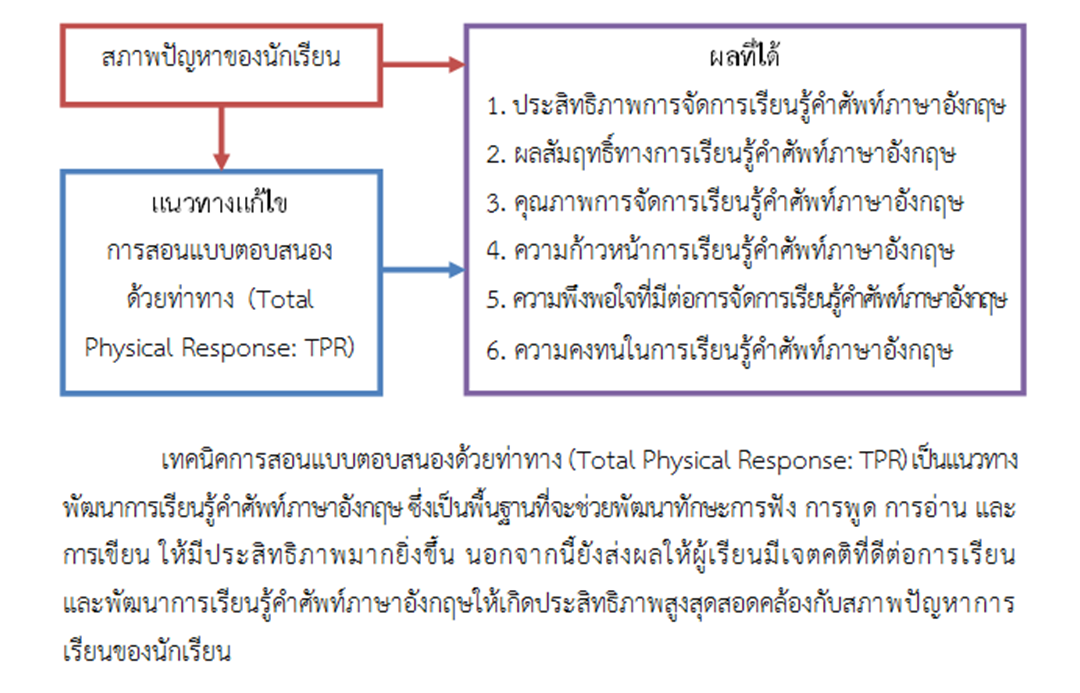THE DEVELOPMENT OF ENGLISH VOCABULARY LEARNING ABILITY BY USING TOTAL PHYSICAL RESPONSE (TPR) FOR GRADE 2 STUDENTS
Main Article Content
Abstract
The objectives of this research article were 1) to develop the processing of English vocabulary learning by using Total Physical Response (TPR), for Grade 2 Students to met the efficiency criterion of the 80/80, 2) to compare the achievement score of English vocabulary before and after learning by using Total Physical Response (TPR), 3) to study the quality of English vocabulary learning with the coefficient of distribution finding, 4) to determine the Effectiveness Index (EI) in English vocabulary learning, 5) to study the satisfaction for learning English vocabulary and 6) to study the retention in learning English vocabulary of grade 2 students. The sample groups in this research were 30 students who studied in grade 2/2, in the first semester of the 2019 academic year at the Demonstration School of Maha Sarakham Rajabhat University. The sample was obtained by Cluster Random Sampling. The instruments used in this study were 3 lesson plans, totaling 15 hours of study time and using Total Physical Response (TPR) in learning, an achievement test of 30 items and 25 items of Learning activities quality assessment form and 15 items of the satisfaction questionnaire. The data were statistically analyzed by mean, standard deviation, percentage and t-test using Dependent Sample was used to compare the achievement scores before and after learning and after 14 days of learning.
The findings revealed that: 1. the efficiency (E1/E2) of English vocabular learning by using Total Physical Response (TPR) of Grade 2 students was 91.76/88.11 which was higher than the set threshold of 80/80. 2. The average achievement score of pre-study was 15.43 and an average achievement score of post-study was 26.43, the average scores in post-study were higher than the pre-study and were significantly different at the 0.01 level of statistic. 3. The average achievement score of post-study was 26.43 and the standard deviation was 1.19. The coefficient of distribution of English vocabulary learning was 4.50. 4. The Effectiveness Index (EI) in English vocabulary learning for grade 2 students by using Total Physical Response (TPR) was 0.7551, indicating that students’ English vocabulary learning ability were increased for 75.51%. 5. The students were satisfied in learning English vocabulary by using Total Physical Response (TPR) at the highest level. 6) The retention in English vocabulary learning of Grade 2 students by using Total Physical Response (TPR) after 14 days of learning was not significantly different.
Article Details

This work is licensed under a Creative Commons Attribution-NonCommercial-NoDerivatives 4.0 International License.
References
ฐานิศวร์ กิจพิสิฐปรีชา. (2556). การพัฒนาการเรียนรู้คำศัพท์ของนักเรียนโดยใช้วิธีสอนแบบตอบสนองด้วยท่าทาง. วิทยานิพนธ์ศิลปศาสตรมหาบัณฑิต สาขาวิชาภาษาอังกฤษ. มหาวิทยาลัยราชภัฏบุรีรัมย์.
ดารุณี คํามูล. (2552). การศึกษาความสามารถด้านการฟัง-พูดภาษาอังกฤษของนักเรียนชั้นประถมศึกษาปีที่ 5 ที่ได้รับการสอนโดยวิธีสอนแบบตอบสนองด้วยท่าทาง. การศึกษาค้นคว้าอิสระปริญญาศึกษาศาสตรมหาบัณฑิต สาขาวิชาหลักสูตรและการสอน. มหาวิทยาลัยขอนแก่น.
ทิศนา แขมมณี. (2542). การจัดการเรียนการสอนโดยยึดผู้เรียนเป็นศูนย์กลาง. กรุงเทพมหานคร : โอเดียนสโตร์.
ประนอม สุรัสวดี. (2535). กิจกรรมและสื่อการสอนวิชาภาษาอังกฤษระดับประถมศึกษา. กรุงเทพมหานคร : สำนักพิมพ์จุฬาลงกรณ์มหาวิทยาลัย.
เผชิญ กิจระการ. (2545). ดัชนีประสิทธิผล. วารสารการวัดผลการศึกษา มหาวิทยาลัยมหาสารคาม. 8(กรกฎาคม). 30–32.
วารุณี ศิริ. (2560). การพัฒนาการจัดการเรียนรู้โดยใช้วิธีสอนแบบตอบสนองด้วยท่าทาง (TPR) ที่มีผลต่อทักษะการฟังและการพูดภาษาอังกฤษ สำหรับนักเรียนชั้นประถมศึกษาปีที่ 1. วิทยานิพนธ์ปริญญาการศึกษามหาบัณฑิต สาขาหลักสูตรและการสอน. มหาวิทยาลัยมหาสารคาม.
ศิริภรณ์ ศรีนาค. (2550). การเปรียบเทียบผลสัมฤทธิ์และเจตคติต่อการเรียนภาษาอังกฤษของนักเรียนชั้นประถมศึกษาปีที่ 3 โดยการสอนแบบตอบสนองด้วยท่าทาง (TPR) กับวิธีสอนตามแนวการสอนภาษาเพื่อการสื่อสาร. วิทยานิพนธ์ปริญญาครุศาสตรมหาบัณฑิต สาขาหลักสูตรและการสอน. มหาวิทยาลัยราชภัฏเทพสตรี.
สำนักงานคณะกรรมการการศึกษาแห่งชาติ. (2554). แผนการศึกษาแห่งชาติ (พ.ศ. 2545-2559). กรุงเทพมหานคร : พริกหวานกราฟฟิค จำกัด.
สิริวิภา จอกลบ. (2553). ทักษะการฟังและการพูดภาษาอังกฤษของนักเรียนชั้นประถมศึกษาปีที่ 2 ที่ได้รับการสอนแบบตอบสนองด้วยท่าทาง. การศึกษาอิสระปริญญาศึกษาศาสตรมหาบัณฑิต สาขาหลักสูตรและการสอน. มหาวิทยาลัยขอนแก่น.
อุดมลักษณ์ เนตรโกศล. (2556). การพัฒนาความสามารถด้านการฟังและการพูดภาษาอังกฤษ โดยใช้วิธีสอนแบบตอบสนองด้วยท่าทางที่ส่งผลต่อแรงจูงใจใฝ่สัมฤทธิ์นักเรียนชั้นมัธยมศึกษา ปีที่ 1. การศึกษาค้นคว้าอิสระปริญญาการศึกษามหาบัณฑิต สาขาหลักสูตรและการสอน. มหาวิทยาลัยมหาสารคาม.
Asher, James. (1982). Learning Another Language Through Actions. California : Production.
Francisco Delgado. (2011). Teaching English Vocabulary to Third Graders Through the Application on the total Physical Response Method. Colombo : Universidad Tecnologica De Pereira.
Goodman R.I., K.A. Fletcher and E.W. Schneider, (1980). The Effectiveness Index as Comparative Measure in Media Product Evaluation. Educational Technology. 20(09). 30-34.
Rashed, Mohamed Khyrat Mahmoud. (1990). The Effect of Total Physical Response Method Versus the Audio-lingual Method on the Rate of Attainment In Listening Comprehension of Egyptian Beginners of English as a Foreign Language. Dissertation Abstracts International. 51(3). 732-A.


